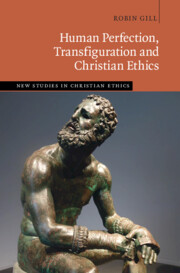Book contents
- Human Perfection, Transfiguration and Christian Ethics
- Reviews
- New Studies in Christian Ethics
- Human Perfection, Transfiguration and Christian Ethics
- Copyright page
- Contents
- Acknowledgements
- Introduction
- Part I Human Perfection
- Part II Jesus’ Perfection
- Part III Transfiguration and Global Perfection
- Chapter 7 Perfection and the Transfiguration
- Chapter 8 Perfection
- Chapter 9 A Perfect Planet
- Epilogue
- Select Bibliography in Christian Ethics
- Index
- Titles Published in the Series (continued from page )
- References
Chapter 8 - Perfection
The Transfiguration and Abrahamic Trust
from Part III - Transfiguration and Global Perfection
Published online by Cambridge University Press: 09 May 2024
- Human Perfection, Transfiguration and Christian Ethics
- Reviews
- New Studies in Christian Ethics
- Human Perfection, Transfiguration and Christian Ethics
- Copyright page
- Contents
- Acknowledgements
- Introduction
- Part I Human Perfection
- Part II Jesus’ Perfection
- Part III Transfiguration and Global Perfection
- Chapter 7 Perfection and the Transfiguration
- Chapter 8 Perfection
- Chapter 9 A Perfect Planet
- Epilogue
- Select Bibliography in Christian Ethics
- Index
- Titles Published in the Series (continued from page )
- References
Summary
Chapter 8 continues this discussion, noting that Moses and Elijah are both held in honour by Jews, Christians and Muslims, as is Jesus by Christians and Muslims (following Christian scholars such as David Thomas). Although there are important and abiding doctrinal differences between these Abrahamic Faiths, particularly about the status of Jesus and Mohammed, this chapter argues that there are crucial ethical commonalities that could and should help to move the world beyond religiously inspired violence. The chapter ends with an extended discussion of Raimon Panikkar’s inspiring vision of the Cosmic Christ in his collected works Omnia Opera.
Keywords
- Type
- Chapter
- Information
- Human Perfection, Transfiguration and Christian Ethics , pp. 169 - 194Publisher: Cambridge University PressPrint publication year: 2024

